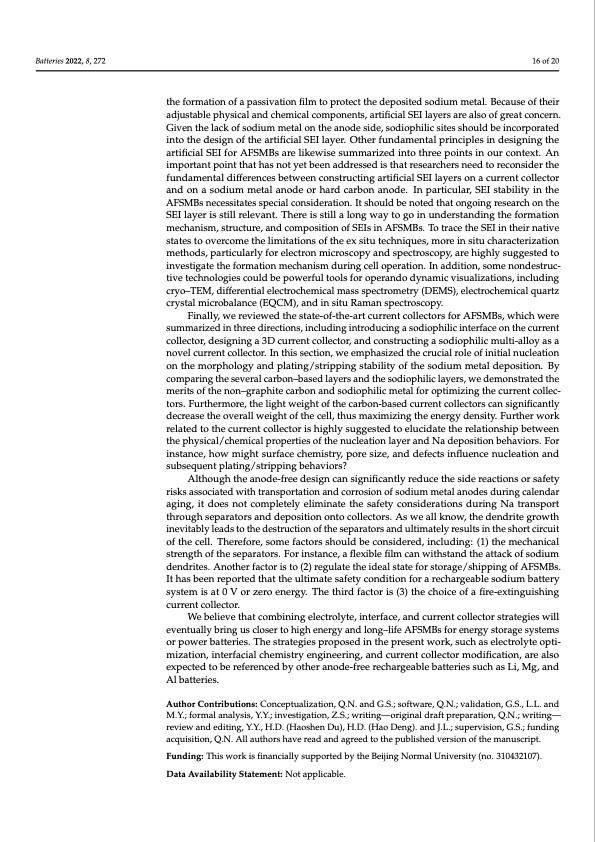
PDF Publication Title:
Text from PDF Page: 016
Batteries 2022, 8, 272 16 of 20 the formation of a passivation film to protect the deposited sodium metal. Because of their adjustable physical and chemical components, artificial SEI layers are also of great concern. Given the lack of sodium metal on the anode side, sodiophilic sites should be incorporated into the design of the artificial SEI layer. Other fundamental principles in designing the artificial SEI for AFSMBs are likewise summarized into three points in our context. An important point that has not yet been addressed is that researchers need to reconsider the fundamental differences between constructing artificial SEI layers on a current collector and on a sodium metal anode or hard carbon anode. In particular, SEI stability in the AFSMBs necessitates special consideration. It should be noted that ongoing research on the SEI layer is still relevant. There is still a long way to go in understanding the formation mechanism, structure, and composition of SEIs in AFSMBs. To trace the SEI in their native states to overcome the limitations of the ex situ techniques, more in situ characterization methods, particularly for electron microscopy and spectroscopy, are highly suggested to investigate the formation mechanism during cell operation. In addition, some nondestruc- tive technologies could be powerful tools for operando dynamic visualizations, including cryo–TEM, differential electrochemical mass spectrometry (DEMS), electrochemical quartz crystal microbalance (EQCM), and in situ Raman spectroscopy. Finally, we reviewed the state-of-the-art current collectors for AFSMBs, which were summarized in three directions, including introducing a sodiophilic interface on the current collector, designing a 3D current collector, and constructing a sodiophilic multi-alloy as a novel current collector. In this section, we emphasized the crucial role of initial nucleation on the morphology and plating/stripping stability of the sodium metal deposition. By comparing the several carbon–based layers and the sodiophilic layers, we demonstrated the merits of the non–graphite carbon and sodiophilic metal for optimizing the current collec- tors. Furthermore, the light weight of the carbon-based current collectors can significantly decrease the overall weight of the cell, thus maximizing the energy density. Further work related to the current collector is highly suggested to elucidate the relationship between the physical/chemical properties of the nucleation layer and Na deposition behaviors. For instance, how might surface chemistry, pore size, and defects influence nucleation and subsequent plating/stripping behaviors? Although the anode-free design can significantly reduce the side reactions or safety risks associated with transportation and corrosion of sodium metal anodes during calendar aging, it does not completely eliminate the safety considerations during Na transport through separators and deposition onto collectors. As we all know, the dendrite growth inevitably leads to the destruction of the separators and ultimately results in the short circuit of the cell. Therefore, some factors should be considered, including: (1) the mechanical strength of the separators. For instance, a flexible film can withstand the attack of sodium dendrites. Another factor is to (2) regulate the ideal state for storage/shipping of AFSMBs. It has been reported that the ultimate safety condition for a rechargeable sodium battery system is at 0 V or zero energy. The third factor is (3) the choice of a fire-extinguishing current collector. We believe that combining electrolyte, interface, and current collector strategies will eventually bring us closer to high energy and long–life AFSMBs for energy storage systems or power batteries. The strategies proposed in the present work, such as electrolyte opti- mization, interfacial chemistry engineering, and current collector modification, are also expected to be referenced by other anode-free rechargeable batteries such as Li, Mg, and Al batteries. Author Contributions: Conceptualization, Q.N. and G.S.; software, Q.N.; validation, G.S., L.L. and M.Y.; formal analysis, Y.Y.; investigation, Z.S.; writing—original draft preparation, Q.N.; writing— review and editing, Y.Y., H.D. (Haoshen Du), H.D. (Hao Deng). and J.L.; supervision, G.S.; funding acquisition, Q.N. All authors have read and agreed to the published version of the manuscript. Funding: This work is financially supported by the Beijing Normal University (no. 310432107). Data Availability Statement: Not applicable.PDF Image | Anode-Free Rechargeable Sodium-Metal Batteries

PDF Search Title:
Anode-Free Rechargeable Sodium-Metal BatteriesOriginal File Name Searched:
batteries-08-00272.pdfDIY PDF Search: Google It | Yahoo | Bing
Salgenx Redox Flow Battery Technology: Salt water flow battery technology with low cost and great energy density that can be used for power storage and thermal storage. Let us de-risk your production using our license. Our aqueous flow battery is less cost than Tesla Megapack and available faster. Redox flow battery. No membrane needed like with Vanadium, or Bromine. Salgenx flow battery
| CONTACT TEL: 608-238-6001 Email: greg@salgenx.com | RSS | AMP |